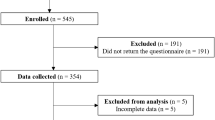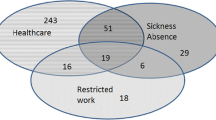Abstract
Purpose
Pain symptom, such as that caused by musculoskeletal disorders, is a major cause of occupational disability. As nicotine intake from smoking increases pain sensitivity, smokers may experience stronger pain and be more likely to experience pain-related disability than non-smokers. The study aim was to examine whether smoking was associated with pain-related occupational disability via pain intensity.
Methods
Participants were 1189 workers with pain aged 20–74 years in Japan. Participants completed a self-report questionnaire, which included a question to measure pain-related occupational disability with ordinal-option: (1) without pain-related disability, (2) pain-related presenteeism, and (3) pain-related absenteeism. An ordinal logistic regression model was used to calculate multivariable-adjusted proportional odds ratios (OR) with 95% confidence intervals (CI) for the prevalence of pain-related occupational disability according to smoking status. A multiple mediation analysis was also conducted to assess whether pain sensitivity mediated the association between smoking and pain-related occupational disability. Adjusted variables were demographic variables, socioeconomic status, work-related psychosocial factors, general psychological factors, and pain duration.
Results
Current smoking and pain were associated with pain-related occupational disability compared with non-smoking and pain (multivariable OR 1.78; 95% CI 1.26–2.52). Greater pain intensity partially mediated the association of current smoking and pain with pain-related occupational disability. The mediation rate (indirect/total effect) was 25%.
Conclusion
Smoking and pain were associated with pain-related occupational disability, partially through greater pain intensity, among Japanese workers.


Similar content being viewed by others
References
Nastasia I, Coutu MF, Tcaciuc R. Topics and trends in research on non-clinical interventions aimed at preventing prolonged work disability in workers compensated for work-related musculoskeletal disorders (WRMSDs): a systematic, comprehensive literature review. Disabil Rehabil. 2014;36:1841–56.
Pergolizzi J, Müller-Schwefe G, Langley P, Nicolaou A, Liedgens H, Varrassi G. The impact of pain on labor force participation, absenteeism and presenteeism in the European Union. J Med Econ. 2010;13:662–72.
Bailey SK, Haggarty J, Kelly S. Global absenteeism and presenteeism in mental health patients referred through primary care. Work. 2016;53:399–408.
Itoh H, Kitamura F, Yokoyama K. Estimates of annual medical costs of work-related low back pain in Japan. Ind Health. 2013;51:524–9.
Grönblad M, Järvinen E, Airaksinen O, Ruuskanen M, Hämäläinen H, Kouri JP. Relationship of subjective disability with pain intensity, pain duration, pain location, and work-related factors in nonoperated patients with chronic low back pain. Clin J Pain. 1996;12:194–200.
Bean DJ, Johnson MH, Kydd RR. Relationships between psychological factors, pain, and disability in complex regional pain syndrome and low back pain. Clin J Pain. 2014;30:647–53.
Woby SR, Roach NK, Urmston M, Watson PJ. The relation between cognitive factors and levels of pain and disability in chronic low back pain patients presenting for physiotherapy. Eur J Pain. 2007;11:869–77.
Hirotsu C, Pedroni MN, Berro LF, Tufik S, Andersen ML. Nicotine and sleep deprivation: impact on pain sensitivity and immune modulation in rats. Sci Rep. 2018;8:1–9.
Al-Bashaireh AM, Haddad LG, Weaver M, Kelly DL, Chengguo X, Yoon S. The effect of tobacco smoking on musculoskeletal health: a systematic review. J Environ Public Health. 2018;2018:1–106.
Weingarten TN, Moeschler SM, Ptaszynski AE, Hooten WM, Beebe TJ, Warner DO. An assessment of the association between smoking status, pain intensity, and functional interference in patients with chronic pain. Pain Physician. 2008;11:643–53.
Yamada K, Wakaizumi K, Fukai K, Iso H, Sobue T, Shibata M, Matsudaira K. Study of chronic pain and its associated risk factors among Japanese industry workers: the Quality of Working Life Influenced by Chronic pain (QWLIC) study. Sangyo Eiseigaku Zasshi. 2017;59:125–34.
Wakaizumi K, Yamada K, Oka H, Kosugi S, Morisaki H, Shibata M, Matsudaira K. Fear-avoidance beliefs are independently associated with the prevalence of chronic pain in Japanese workers. J Anesth. 2017;31:255–62.
Turk DC, Dworkin RH, Allen RR, Bellamy N, Brandenburg N, Carr DB, Cleeland C, Dionne R, Farrar JT, Galer BS, Hewitt DJ. Core outcome domains for chronic pain clinical trials: IMMPACT recommendations. Pain. 2003;106:337–45.
Schaufeli WB, Shimazu A, Taris TW. Being driven to work excessively hard. Cross Cult Res. 2009;43:320–48.
Shimomitsu T, Haratani T, Nakamura K, Kawakami N, Hayashi T. The final development of the Brief Job Stress Questionnaire mainly used for assessment of the individuals. The ministry of Labour sponsored grand for the prevention of work-related illness: The 1999 report. 1990. pp. 126–64.
Furukawa TA, Kawakami N, Saitoh M, Ono Y, Nakane Y, Nakamura Y, Tachimori H, Iwata N, Uda H, Nakane H, Watanabe M, Naganuma Y, Hata Y, Kobayashi M, Miyake Y, Takeshima T, Kikkawa T. The performance of the Japanese version of the K6 and K10 in the World Mental Health Survey Japan. Int J Methods Psychiatr Res. 2008;17:152–8.
Babyak MA. Understanding confounding and mediation. Evid Based Ment Health. 2009;12:68–71.
Monzani L, Zurriaga R, López GVE. Anxiety and the severity of tension-type headache mediate the relation between headache presenteeism and workers’ productivity. PLoS One. 2018;13:1–16.
Stewart WF, Ricci JA, Chee E, Morganstein D, Lipton R. Lost productive time and cost due to common pain conditions in the US workforce. JAMA. 2003;290(2443):2454.
de Kruijf M, Peters MJ, C Jacobs L, Tiemeier H, Nijsten T, Hofman A, Uitterlinden AG, Huygen FJ, van Meurs JB. Determinants for quantitative sensory testing and the association with chronic musculoskeletal pain in the general elderly population. Pain Pract. 2016;16:831–41.
Sivertsen B, Lallukka T, Petrie KJ, Steingrímsdóttir ÓA, Stubhaug A, Nielsen CS. Sleep and pain sensitivity in adults. Pain. 2015;156:1433–9.
Shiels MS, Katki HA, Freedman ND, Purdue MP, Wentzensen N, Trabert B, Kitahara CM, Furr M, Li Y, Kemp TJ, Goedert JJ, Chang CM, Engels EA, Caporaso NE, Pinto LA, Hildesheim A, Chaturvedi AK. Cigarette smoking and variations in systemic immune and inflammation markers. J Natl Cancer Inst. 2014;106:1–8.
Afari N, Mostoufi S, Noonan C, Poeschla B, Succop A, Chopko L, Strachan E. C-reactive protein and pain sensitivity: findings from female twins. Ann Behav Med. 2011;42:277–83.
Karanika-Murray M, Pontes HM, Griffiths MD, Biron C. Sickness presenteeism determines job satisfaction via affective-motivational states. Soc Sci Med. 2015;139:100–6.
Gard G, Sandberg AC. Motivating factors for return to work. Physiother Res Int. 1998;3:100–8.
Mohamed TS, Jayakar SS, Hamouda AK. Orthosteric and allosteric ligands of nicotinic acetylcholine receptors for smoking cessation. Front Mol Neurosci. 2015;8:1–9.
Grundey J, Amu R, Batsikadze G, Paulus W, Nitsche MA. Diverging effects of nicotine on motor learning performance: improvement in deprived smokers and attenuation in non-smokers. Addict Behav. 2017;74:90–7.
Zou Z, Wang H, d’Oleire Uquillas F, Wang X, Ding J, Chen H. Definition of substance and non-substance addiction. Adv Exp Med Biol. 2017;1010:21–41.
Acknowledgements
We are grateful to all the participants from the three companies. We thank Dr. Kyosuke Fukai, Dr. Yuichiro Kawatsu, Dr. Azusa Shima, and other staffs from the three companies for their support in conducting this survey. We thank Diane Williams, Ph.D., from Edanz Group (http://www.edanzediting.com/ac) for editing a draft of this manuscript.
Funding
This research was supported by a grant for The Research Project on Elucidation of Chronic Pain from the Japan Agency for Medical Research and Development, AMED (16EK0610004H0003), Health Labour Sciences Research Grants, and Industrial Disease Clinical Research Grants (14020301-01). This research was supported in part by a fellowship to Keiko Yamada from the Astellas Foundation for Research on Metabolic Disorders and supported in part by a research assistantship of a Grant-in-Aid to Kenta Wakaizumi and the Program for Leading Graduate School for “Science for Development of Super Mature Society” from the Ministry of Education, Culture, Sport, Science, and Technology in Japan.
Author information
Authors and Affiliations
Corresponding author
Ethics declarations
Conflict of interest
The authors have no conflicts of interest to declare.
Additional information
Publisher's Note
Springer Nature remains neutral with regard to jurisdictional claims in published maps and institutional affiliations.
Electronic supplementary material
Below is the link to the electronic supplementary material.
About this article
Cite this article
Yamada, K., Wakaizumi, K., Kubota, Y. et al. Smoking is associated with greater pain intensity and pain-related occupational disability in Japanese workers. J Anesth 33, 523–530 (2019). https://doi.org/10.1007/s00540-019-02661-1
Received:
Accepted:
Published:
Issue Date:
DOI: https://doi.org/10.1007/s00540-019-02661-1




